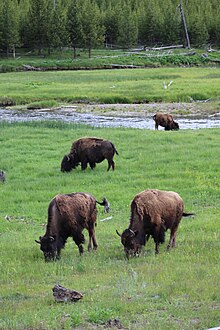
The conservation of bison in North America is an ongoing, diverse effort to bring American bison (Bison bison) back from the brink of extinction. Plains bison, a subspecies (Bison bison bison), are a keystone species in the North American Great Plains. Bison are a species of conservation concern in part because they suffered a severe population bottleneck at the end of the 19th century. The near extinction of the species during the 19th century unraveled fundamental ties between bison, grassland ecosystems, and indigenous peoples’ cultures and livelihoods. English speakers used the word buffalo for this animal when they arrived.[1] Bison was used as the scientific term to distinguish them from the true buffalo. Buffalo is commonly used as it continues to hold cultural significance, particularly for Indigenous people.[2]
Recovery began in the late 19th century with a handful of individuals independently saving the last surviving bison. Dedicated restoration efforts in the 20th century bolstered bison numbers though they still exist in mostly small and isolated populations. Expansion of the understanding of bison ecology and management is ongoing. The contemporary widespread, collaborative effort includes attention to heritage genetics and minimal cattle introgression.
- ^ "Bison, Buffalo, Tatanka: Bovids of the Badlands". U.S. National Park Service. November 10, 2020. Archived from the original on August 7, 2020. Retrieved January 14, 2022.
- ^ Cite error: The named reference
SM 2023-09-13was invoked but never defined (see the help page).